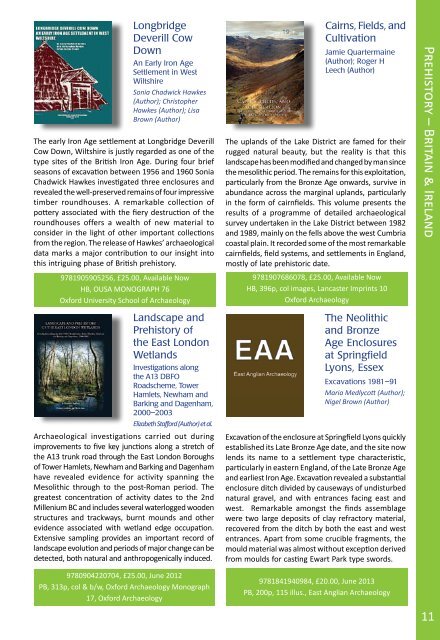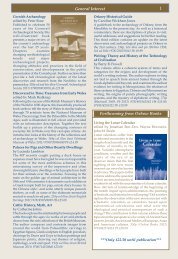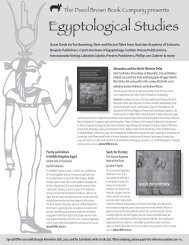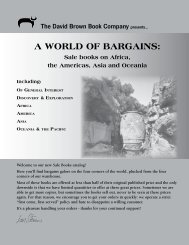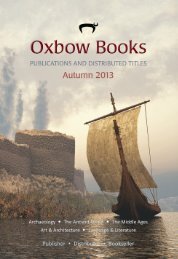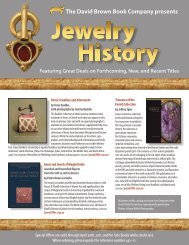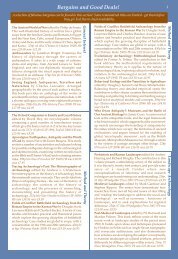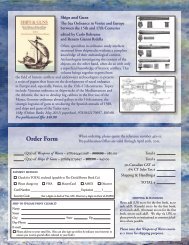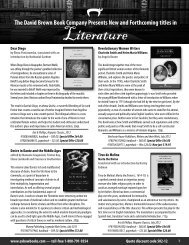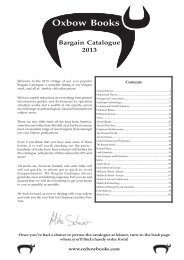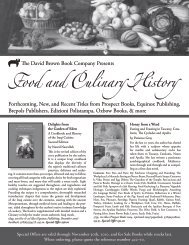Oxbow Spring 2013.pdf - Oxbow Books
Oxbow Spring 2013.pdf - Oxbow Books
Oxbow Spring 2013.pdf - Oxbow Books
Create successful ePaper yourself
Turn your PDF publications into a flip-book with our unique Google optimized e-Paper software.
Longbridge<br />
Deverill Cow<br />
Down<br />
An Early Iron Age<br />
Settlement in West<br />
Wiltshire<br />
Sonia Chadwick Hawkes<br />
(Author); Christopher<br />
Hawkes (Author); Lisa<br />
Brown (Author)<br />
The early Iron Age settlement at Longbridge Deverill<br />
Cow Down, Wiltshire is justly regarded as one of the<br />
type sites of the British Iron Age. During four brief<br />
seasons of excavation between 1956 and 1960 Sonia<br />
Chadwick Hawkes investigated three enclosures and<br />
revealed the well-preserved remains of four impressive<br />
timber roundhouses. A remarkable collection of<br />
pottery associated with the fiery destruction of the<br />
roundhouses offers a wealth of new material to<br />
consider in the light of other important collections<br />
from the region. The release of Hawkes’ archaeological<br />
data marks a major contribution to our insight into<br />
this intriguing phase of British prehistory.<br />
9781905905256, £25.00, Available Now<br />
HB, OUSA MONOGRAPH 76<br />
Oxford University School of Archaeology<br />
Landscape and<br />
Prehistory of<br />
the East London<br />
Wetlands<br />
Investigations along<br />
the A13 DBFO<br />
Roadscheme, Tower<br />
Hamlets, Newham and<br />
Barking and Dagenham,<br />
2000–2003<br />
Elizabeth Stafford (Author) et al.<br />
Archaeological investigations carried out during<br />
improvements to five key junctions along a stretch of<br />
the A13 trunk road through the East London Boroughs<br />
of Tower Hamlets, Newham and Barking and Dagenham<br />
have revealed evidence for activity spanning the<br />
Mesolithic through to the post-Roman period. The<br />
greatest concentration of activity dates to the 2nd<br />
Millenium BC and includes several waterlogged wooden<br />
structures and trackways, burnt mounds and other<br />
evidence associated with wetland edge occupation.<br />
Extensive sampling provides an important record of<br />
landscape evolution and periods of major change can be<br />
detected, both natural and anthropogenically induced.<br />
9780904220704, £25.00, June 2012<br />
PB, 313p, col & b/w, Oxford Archaeology Monograph<br />
17, Oxford Archaeology<br />
Cairns, Fields, and<br />
Cultivation<br />
Jamie Quartermaine<br />
(Author); Roger H<br />
Leech (Author)<br />
The uplands of the Lake District are famed for their<br />
rugged natural beauty, but the reality is that this<br />
landscape has been modified and changed by man since<br />
the mesolithic period. The remains for this exploitation,<br />
particularly from the Bronze Age onwards, survive in<br />
abundance across the marginal uplands, particularly<br />
in the form of cairnfields. This volume presents the<br />
results of a programme of detailed archaeological<br />
survey undertaken in the Lake District between 1982<br />
and 1989, mainly on the fells above the west Cumbria<br />
coastal plain. It recorded some of the most remarkable<br />
cairnfields, field systems, and settlements in England,<br />
mostly of late prehistoric date.<br />
9781907686078, £25.00, Available Now<br />
HB, 396p, col images, Lancaster Imprints 10<br />
Oxford Archaeology<br />
The Neolithic<br />
and Bronze<br />
Age Enclosures<br />
at <strong>Spring</strong>field<br />
Lyons, Essex<br />
Excavations 1981–91<br />
Maria Medlycott (Author);<br />
Nigel Brown (Author)<br />
Excavation of the enclosure at <strong>Spring</strong>field Lyons quickly<br />
established its Late Bronze Age date, and the site now<br />
lends its name to a settlement type characteristic,<br />
particularly in eastern England, of the Late Bronze Age<br />
and earliest Iron Age. Excavation revealed a substantial<br />
enclosure ditch divided by causeways of undisturbed<br />
natural gravel, and with entrances facing east and<br />
west. Remarkable amongst the finds assemblage<br />
were two large deposits of clay refractory material,<br />
recovered from the ditch by both the east and west<br />
entrances. Apart from some crucible fragments, the<br />
mould material was almost without exception derived<br />
from moulds for casting Ewart Park type swords.<br />
9781841940984, £20.00, June 2013<br />
PB, 200p, 115 illus., East Anglian Archaeology<br />
Prehistory – Britain & Ireland<br />
11


